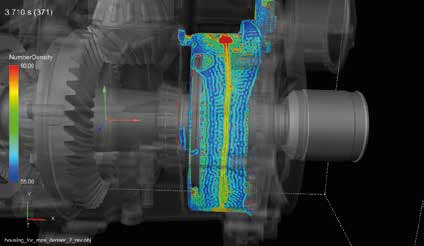
Overview
Dana Incorporated, a leading supplier of automotive powertrain components, is renowned for the exceptional capabilities and value of their products. To maintain their competitive edge and continue delivering top-notch products, the Advanced Methods group at the Dana Technical Center continually seeks innovative technologies to enhance their engineering and design processes.
Exploring Innovative Technology
In 2015, the team at Dana embarked on an evaluation of Particleworks, a cutting-edge simulation tool designed to predict fluid dynamics in complex systems. Their goal was to determine the efficacy of Particleworks in predicting the accumulation of oil on the surface of a rotating component within one of their axle assemblies.
Particleworks: A Mesh-Free Simulation Tool
Particleworks utilizes the Moving Particle Simulation (MPS) methodology, a mesh-free approach that allows for the precise simulation of fluid behavior in dynamic systems. This technology is particularly advantageous for modeling scenarios involving complex movements and interactions, such as those found in automotive powertrains.
Application and Results
Dana’s evaluation focused on an axle assembly, specifically examining the oil accumulation on the spinning wheel located on the right side of the assembly. The study included side and top views of the component to comprehensively assess Particleworks’ predictive accuracy.
- Side View Analysis: The top images in the study illustrated the side view of the axle assembly. Particleworks successfully predicted the pattern of oil accumulation, demonstrating a close match to the behavior observed in actual physical tests.
- Top View Analysis: The bottom images provided a top-down perspective, further validating the simulation tool’s accuracy in replicating real-world oil behavior.
Validation and Implementation
The validation of Particleworks’ predictions against physical test results was a significant milestone for Dana. The close alignment between simulated and actual oil accumulation patterns confirmed the reliability of Particleworks as a simulation tool. This success encouraged Dana to integrate Particleworks into their engineering processes, enabling more precise and efficient design of their powertrain components.
Benefits and Future Prospects
By adopting Particleworks, Dana has enhanced its ability to accurately predict fluid dynamics within their powertrain systems. This has several key benefits:
- Improved Design Accuracy: The ability to simulate oil behavior with high precision allows for more accurate and reliable component designs.
- Reduced Development Time: Simulations can identify potential issues early in the design process, reducing the need for extensive physical prototyping and testing.
- Cost Savings: With fewer prototypes and more efficient design iterations, the overall cost of product development is significantly lowered.
- Enhanced Product Performance: Accurate simulations lead to better-performing components, ultimately resulting in higher-quality products for Dana’s customers.
Conclusion
Dana Incorporated’s successful implementation of Particleworks exemplifies the transformative impact of advanced simulation tools on the automotive industry. By leveraging the capabilities of Particleworks, Dana has not only improved their design processes but also set a new standard for innovation and precision in powertrain engineering.
For a detailed account of Dana’s evaluation and the benefits of using Particleworks, read the full success story here: Dana’s Success Story.
This case study provides valuable insights into how cutting-edge simulation technology can drive advancements in automotive design and engineering, ensuring that companies like Dana remain at the forefront of the industry.
